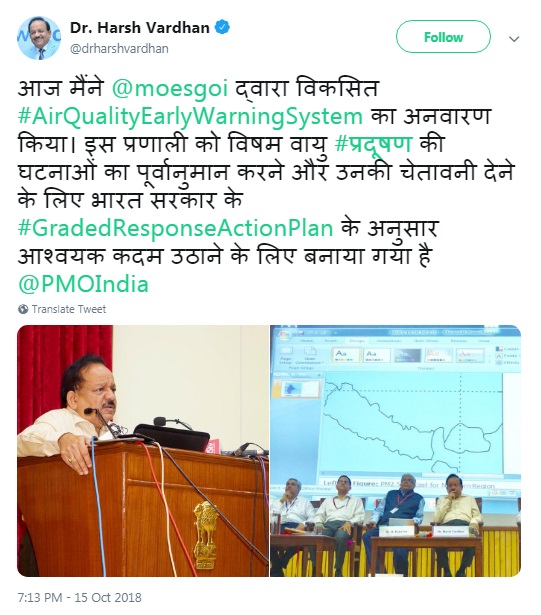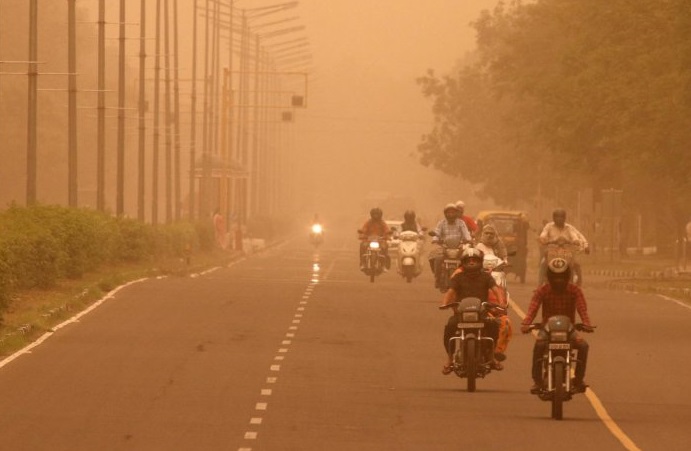Air Quality Early Warning System for Delhi was launched in Delhi on October 15, 2018 by the Union Minister for Earth Sciences and Environment, Dr. Harsh Vardhan. The System is designed to predict extreme air pollution events and give alerts to take necessary steps as per Graded Response Action Plan (GRAP) of the Government of India. The air pollution system has been developed jointly by the scientists at Indian Institute of Tropical Meteorology (IITM), Pune, India Meteorological Department and National Centre for Medium Range Weather Forecasting (NCMRWF).

(Also read: A Museum on Prime Ministers of India to be set up in Delhi)
Speaking at the launch, Dr. Harsh Vardhan said that the early warning system will help in proactively forewarning, 3-4 days in advance, any large scale air pollution events which may occur over the Delhi region. Outlining a series of efforts that the central government has taken the Union Minister said that the Central Pollution Control Board (CPCB) has constituted a 41 member team which will continuously monitor the air pollution levels in Delhi and NCR region and will report to the board. “Badarpur thermal power plant is being closed today, western peripheral expressway is likely to become operational in the first week of November, the Central govt. has released nearly 600 crores to concerned states for in-situ management of crop-residue and a slew of mitigation measures have been taken by the government”, the Minister added.

(Also read: SBI Net Banking facility may be blocked if Mobile Number is not registered by Dec 1, 2018)
A new website developed for archiving all the observational and prediction products was also launched at the event. The website will be accessed by the officials of Environmental Pollution Authority (EPA) and the Central Pollution Control Board (CPCB) for taking necessary steps depending upon the requirements. Ministry of Earth Sciences will be making further attempts to assimilate more data of other pollutants and also to improve accuracy of predictions with the technical support from the NCAR, USA and Finnish Meteorological Institute.
(Also read: Home Ministry launches portal for reporting Online Sexual Abuse and Cyber Crimes)
The air pollution system has been developed jointly by the scientists at Indian Institute of Tropical Meteorology (IITM), Pune, India Meteorological Department and National Centre for Medium Range Weather Forecasting (NCMRWF). The warning system consists of:
a) Real time observations of air quality over Delhi region and details about natural aerosols like dust (from dust storms) and particulate matter using different satellite data sets
b) Predictions of air pollutants from two different air quality prediction systems based on state-of-the-art atmospheric chemistry transport models and
c) Warning Messages and Alerts and Bulletins.
(Also read: Online portal for grant of Industrial Entrepreneurs Memorandum and Industrial License)
The prediction systems were developed by scientists of MoES institutions with the technical support from the National Centre for Atmospheric Research (NCAR), USA and the Finnish Meteorological Institute (FMI). The prediction part of the system consists of two modeling framework, one is based on NCAR atmospheric chemistry transport model and the second one is based on Finnish Meteorological Institute model. The modeling framework typically consists of a high resolution weather prediction model with an atmospheric chemistry transport model. Both the models have data assimilation facility, which can assimilate data from satellites on dust aerosols, particulate matter from stubble burning and other air pollutants like Sulfur dioxide (SO2) and Nitrogen dioxide (NO2). The models will take into account the background aerosols and pollutants, long range transport of dust from dust storms and particulate matter from stubble burning. The predictions are now available up to 72 hours lead time.
(Also read: Home Ministry exempts Sikh women from wearing helmet in Chandigarh)
Union Minister also released a mega emission inventory of Delhi which was made by scientists at IITM, Pune who carried out a mega emission inventory campaign involving around 140 students mapping all possible local sources of air pollution with around 37,500 hours of work. The final product with 400 m x 400m high-resolution emission inventory of Delhi and fringe area of all eight important air pollutants (like PM2.5, PM10, NOx, CO, SO2, BC, OC and VOCs) was released. Ground level activity data about emissions from as many as 23 different sources of pollution were also collected. The emission inventory suggests that there is a substantial increase of emissions from transport and industrial sector, while the contributions from residences have shown a substantial decline.
(Also read: Online Safety Tips for Parents, Youngsters and Organisation)
(Also read: Google limits access of users data by Third Party app)
For more updates:
1. Like our Facebook Page
2. Join our Telegram Group
3. Join our Facebook Group
4. Subscribe to our Youtube Channel
5. Follow us on Twitter
6. Follow us on Instagram
Disclaimer: The above post includes some content used from PIB India website and executed on this website for fair use only. As this website is of educational nature, hence the content is used for education and awareness to the public.

